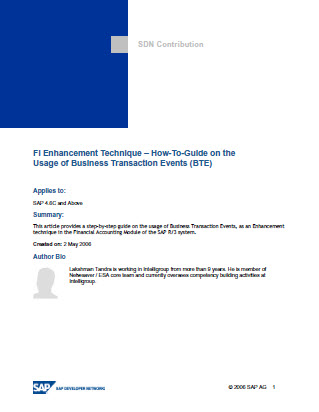In the next few installments of this blog I will be inviting a good friend of mine Tim Moore to teach us about two little known SAP Enhancement techniques, BTE’s and BDT’s Here is a little bit about Tim….
Tim Moore is the president of 4 Ever Moore Enterprises, L.L.C., located outside of Charlotte, North Carolina. Tim has over 15 years of experience with SAP including ERP, SRM, CRM, SCM, BI and XI. He has technical middleware experience as well as functional knowledge in many different industry solutions, such as FI, CO, MM, PP, SD, PS, HCM. He has Solutions Architect experience as well as expertise in SAP Business Workflow, ABAP and Form development. He made his way into programming as an MM functional SME who grew tired of laying out technical requirements for developers, so he decided to teach himself to code ABAP. Since then, he has taken courses in ABAP, expanded to Web programming languages, and learned XML to help with integration points with SAP. Prior to programming, Tim was a Business School graduate and served as a manufacturing manager for a company who implemented SAP. He continues to build his professional skills by expanding his business and technical knowledge in new areas. You can reach him at [email protected]
Enhancements: BTE and BDT
There are many options for enhancements in SAP. This blog will touch on two little known but very powerful options, BTEs and BDTs. We will discuss what they are and how they may be leveraged.
To begin, we must keep in mind every SAP implementation is different. That is because every business is different in the details related to their individual business processes and/or master data. Even within the same company or entity, there can be slight or major differences in a business process or master data based on an enterprise slice. Some parts of the organization perform business one way, while another performs business another. While this is a challenge during implementations, SAP has delivered many different enhancement options. These may be leveraged by the design and development teams to meet the needs of the organization. Enhancement options are always preferable to core modifications when possible.
The acronym BTE stands for Business Transaction Events. This type of enhancement is typically leveraged in FI and SD transaction objects for process modification.
The acronym BDT stands for Business Data Tool-set. This type of enhancement can offer exits in the Master Data maintenance for certain objects.
While both of these types of enhancement objects have been around for several years, many developers outside of those areas mentioned above are only part-time supporting them and may not be as familiar or comfortable as they could be with a little knowledge. So, my wish is for this blog to shed some light on these lesser known enhancement options. Lets take each enhancement type, starting with BTEs, in turn.
BTE – What are they?
BTEs are similar to BADIs (Business Add-Ins) and as such, BTE performance is equally as good. BADIs typically provide windows into existing processes to allow modifications to be made to enhance SAP processes to fit an organization’s requirements. The BTEs are positioned strategically in transactional processes to allow enhancements to core SAP processes which will be supported with future SAP releases. This API (application programming interface) access through the BTE allows for transactional data to be modified by means of custom programming. Some business requirements necessitate a warning or exception message be raised. Many BTEs provide these windows.
BTE – Why do we use them?
– Supported SAP Enhancement Spots – These are delivered windows for customer enhancements supported with future SAP releases
– Generate Custom Message Alerts – Custom validations/checks may be raised in the BTEs. This provides alert windows for messaging
– Data Modification – Modification of data may be made within the confines of the business process
– Provide Windows into Standard SAP Processes – Modifications to SAP processes may be made at certain points recommended by SAP and their process experts. This window is where ABAP may be leveraged, so any custom process specific to the organization may be triggered or terminated. Again, these windows allow custom code to enhance the processes. Workflows, conversions, interfaces, forms, etc all may be triggered from these event windows
BTE – When do we use them?
Typically, these are used when standard SAP processes and organizational process requirements are not consistent. The fact that these are requirements and not ‘nice to haves’, implies that some modification must be made otherwise the process will not pass integration or user acceptance testing. When this occurs, enhancement requests are generated and enhancements begin.
To find if there are BTEs available for use, there are 2 ways of determining them.
– Check in transaction FIBF or in the SAP menu path: SAP Reference IMG -> Financial Accounting -> Financial Accounting Global Settings -> Business Transaction Events
– Open the main program of the transaction you are wanted to enhance and search for character string “OPEN_FI_PERFORM” in the source code
BTE – Build and Use
I typically don’t like re-inventing the wheel, so I’m going to provide links to some additional documentation already created and provided by SAP
First let’s take a look at the SAP SCN Community Network for 50,00 foot look at BTE’s
Next, a complete How-To-Guide on the Usage of Business Transaction Events
Summary
So in summary, we have discussed what BTEs are, why to use them, and how. I also provided useful links to existing SAP documentation for a step by step Build and use case.
In Part 2 of this blog, I will cover the What, Why, When, and How of BDTs.






